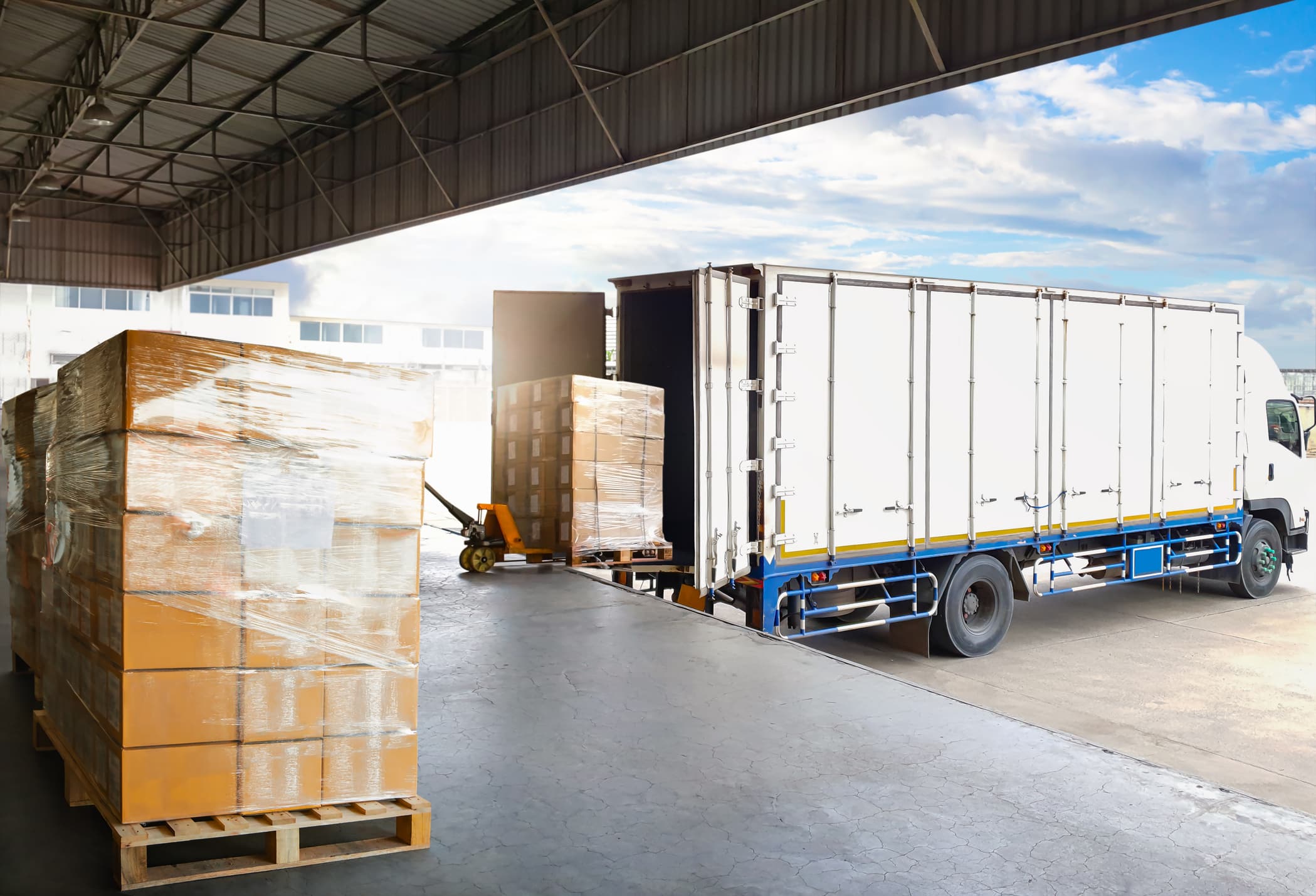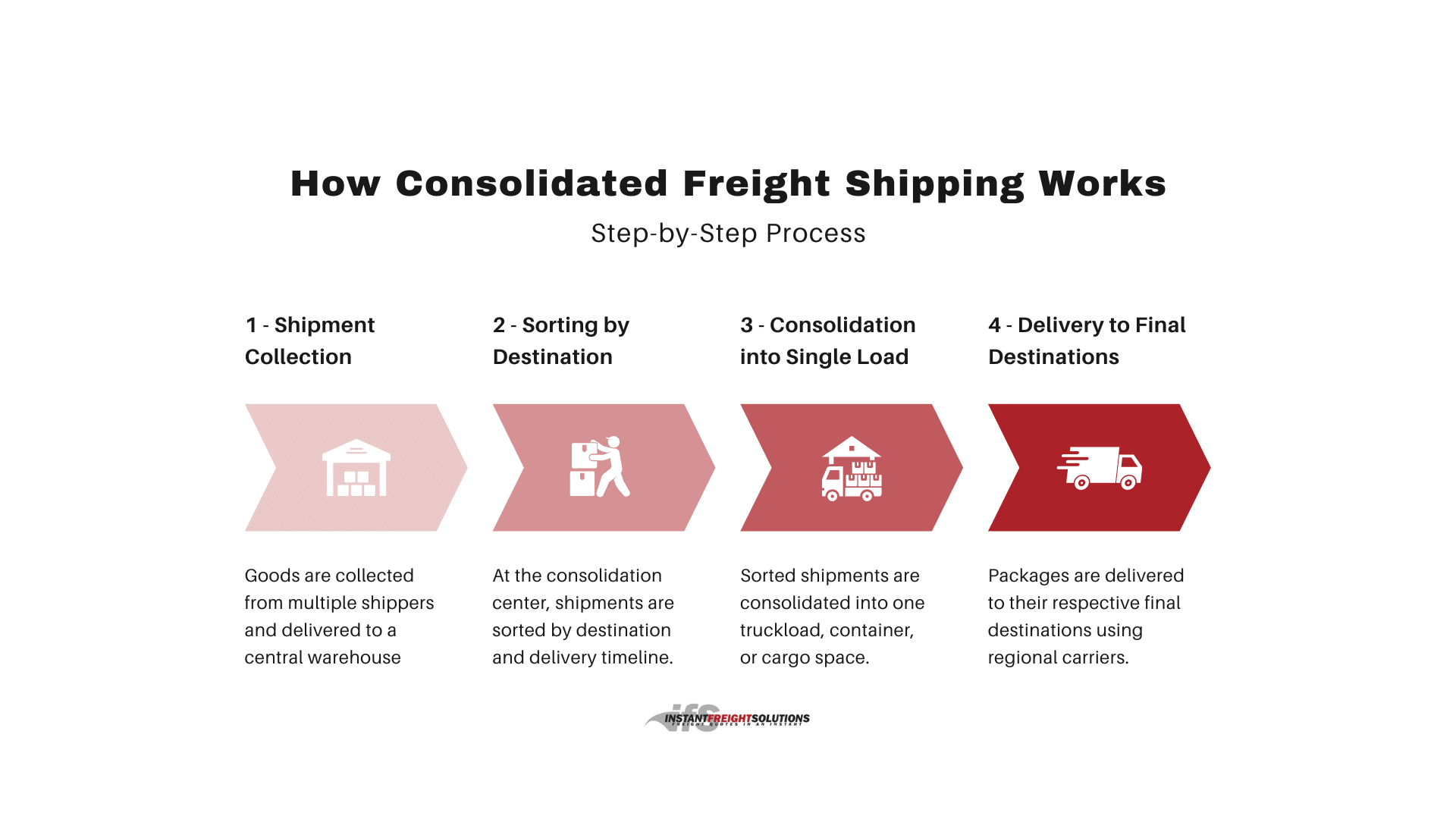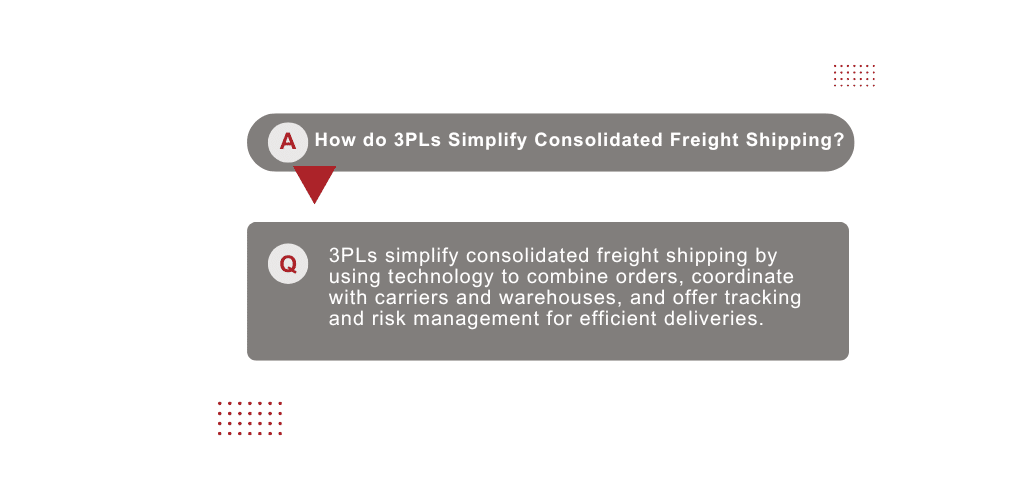What is Consolidated Freight Shipping?

Consolidated freight shipping, often referred to as freight consolidation, is a transportation method where multiple smaller shipments from different shippers are combined into a single truckload, container, or cargo space. By combining shipments that are headed to the same destination or along the same route, this method optimizes logistics, reduces costs, and minimizes the environmental impact of shipping.
This approach is ideal for businesses or individuals who need to move goods but don’t have enough volume to justify a full truckload (FTL). Instead of paying for the entire space of a truck, they pay only for the portion they use.
How Does Consolidated Freight Shipping Work?
Consolidation services begin with shipment collection, during which shippers send goods to a central warehouse, collection point, or consolidation center. These shipments are typically smaller than a full truckload but too large to ship cost-effectively through parcel carriers. At the warehouse, shipments are sorted and consolidated based on their destination and delivery timelines. Goods traveling to similar locations are grouped together to form a single shipment.
Once the shipments are consolidated, they are loaded onto trucks, containers, or other transport vehicles and sent to their destination. Depending on the requirements, this step may involve multimodal or intermodal transportation, a combination of trucking, rail, or ocean freight.
Finally, upon reaching the destination hub, the consolidated shipment is separated, and the individual goods are delivered to their final destinations. This process is often managed through a network of regional carriers to ensure timely and accurate deliveries.

What is the Role of a Freight Consolidator?
The freight consolidators are responsible for collecting the goods from multiple shippers, organizing them at the central warehouse or distribution center, and preparing them for transportation. They ensure shipments are grouped accurately based on destination and delivery timelines, facilitating the transition between collection and delivery.
Benefits of Consolidated Freight Shipping
Consolidated freight shipping offers a range of advantages that make it a preferred shipping method. Widely available and accessible to businesses of all sizes, it provides solutions that are useful for nearly everyone involved in the shipping process.
- Cost Savings: Sharing truck space means shippers only pay for the portion they use. This reduces the overall shipping costs compared to paying for an entire truck or full container.
- Environmental Impact: Consolidating shipments reduces the number of trucks on the road, which means fewer trucks overall, lowering fuel consumption, reducing greenhouse gas emissions, and helping decrease the overall carbon footprint of shipping operations.
- Flexibility for Small and Medium Shipments: It’s an ideal solution for smaller businesses that frequently ship less-than-truckload (LTL) quantities but still want to benefit from competitive rates and streamlined logistics.
- Improved Logistics: Consolidated shipping providers often have access to extensive networks and advanced logistics technology, ensuring efficient routing and faster delivery times.
- Reduced Handling: Consolidated loads undergo less handling compared to traditional LTL shipping, minimizing potential risks of damage or loss during transit.
What Industries Benefit from Consolidated Shipping Services?
Freight consolidation services support a wide range of industries. From small businesses to large-scale manufacturers, it meets the needs of organizations looking to efficiently manage their supply chain.
- Small Businesses: Companies that ship small or medium quantities of goods and want to save on logistics costs.
- Retailers: Stores that frequently receive shipments from multiple suppliers but don’t require a full truckload.
- E-commerce Platforms: Online businesses that must efficiently deliver goods to multiple customers.
- Manufacturers: Factories that ship parts, components, or finished products to multiple locations.
- Distributors: Organizations that handle inventory for multiple clients across a region or country.
Consolidated Freight Shipping vs LTL Shipments
While consolidated freight shipping and less-than-truckload (LTL) shipping share similarities, there are important distinctions:
- Cost Structure: Consolidated freight typically offers lower freight costs by optimizing space and reducing handling fees. LTL shipping, on the other hand, involves multiple stops and handling, which can increase transportation costs.
- Handling: Consolidated freight shipments experience fewer touchpoints, reducing the risk of damage or loss. LTL freight shipments often involve multiple transfers between terminals.
- Transit Time: Consolidated freight is generally faster since the shipments are grouped strategically and routed directly. LTL shipments can take longer due to multiple delivery stops.
How to Prepare Freight for Consolidated Shipping
Preparing a shipment for cargo consolidation involves careful planning and attention to detail. Proper preparation reduces the risk of delays, damage, or additional costs.
Here are the key steps to follow:
- Proper Packaging: Use sturdy boxes, pallets, or crates to protect goods during transit. Label packages clearly with the destination address and contact details.
- Accurate Dimensions and Weight: Provide precise measurements and weights for the shipment. This information helps the logistics provider optimize space and calculate costs.
- Documentation: Prepare all necessary shipping documents, including a bill of lading (BOL), commercial invoice (if applicable), freight RFP, and packing list.
- Effective Communication with the Provider: Clearly communicate pickup and delivery requirements, including any special handling instructions.
- Insurance: Consider purchasing freight insurance to cover the value of goods during transit.
Challenges of Consolidated Freight Shipping
While this shipping option has many advantages, there are potential challenges to consider:
- Coordination: Consolidating freight requires precise planning to ensure shipments are grouped effectively and delivered on time.
- Transit Time Variability: Although consolidated freight can be faster than LTL, delays may occur if shipments wait for other goods to complete a load.
- Space Limitations: During peak shipping seasons, finding available space in a consolidated shipment can be challenging.
- Potential for Miscommunication: Misaligned expectations or unclear instructions can lead to delays or delivery errors.
How Can Logistics Providers and 3PLs Help Combine Orders?

Third-party logistics providers (3PLs) simplify consolidated shipping by combining orders headed to similar destinations. They use advanced software to identify opportunities for consolidation and coordinate with carriers, warehouses, and regional hubs for smooth shipment execution. 3PLs also offer tracking systems for visibility, risk management services, like handling insurance and compliance documentation, and customized solutions to reduce the complexities in the shipping process.
Tips for Choosing a Consolidated Freight Provider
- Reputation: Look for providers with a proven track record of reliability and on-time deliveries.
- Network Coverage: Ensure the provider has a network that covers the required pickup and delivery locations.
- Technology: Advanced tracking systems and route optimization technology can improve visibility and efficiency.
- Customer Support: Responsive customer service is essential for resolving any issues quickly.
- Transparent Pricing: Opt for providers that offer clear and upfront pricing with no hidden fees.
Partner with Instant Freight for Simplified Freight Shipping
At Instant Freight Solutions, we specialize in providing customized freight services for your needs, including:
- Less-Than-Truckload (LTL) Freight: Ideal for smaller shipments, our LTL services ensure timely delivery without the expense of a full truckload.
- Full Truckload (FTL) Services: For larger shipments, we offer competitive pricing, leveraging our extensive carrier network to find the best route and rate for your full truckload needs.
- Intermodal Shipping: We simplify multimodal transportation, combining road, rail, and other modes to increase efficiency and reduce costs for your shipments.
Our proprietary Intelli-Freight System provides real-time quotes from multiple carriers, allowing you to compare delivery costs and choose the best shipping option instantly. With a commitment to responsive communication and going the extra mile, our team ensures a positive experience for every customer.
Contact us today to learn how we can handle your consolidated freight needs and help your business move forward.
